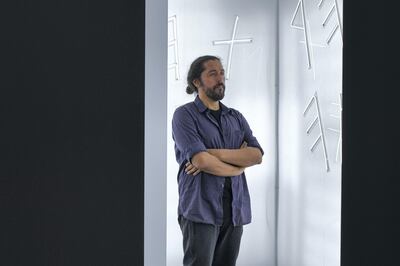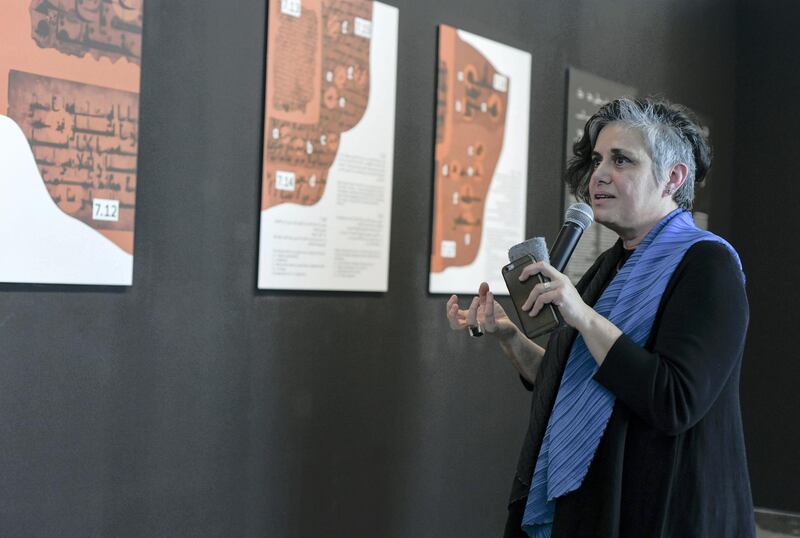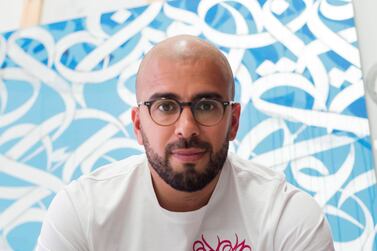We live in an age when questions of identity seem inescapable. Gender, ethnicity, religion, ideology and more have become the fundamental lenses through which politics and culture are now practised, discussed and understood, which makes the latest and very ambitious show at Warehouse421 very much a show for our times.
Nomadic Traces: Journeys of Arabian Scripts blends archaeology, ancient history and the study of ancient scripts and alphabets with contemporary design and a critique of current attitudes to Arab identity, history and heritage. “We always talk about Arabic culture and Arabic script, but that is only the latest iteration. We don’t speak so much about what came before and what led to it,” explains the show’s curator, Huda Smitshuijzen Abifares.
“The information is out there, but it’s for specialists; ordinary people don’t know about the roots of their cultural DNA. The whole system of alphabetical writing was born here. It had an influence on what is now the Arab region and it also had an influence on the West.”
The history of writing in the region
Abifares is a Lebanese designer, academic and curator who lives in Amsterdam, and founded the Khatt Foundation, a cultural organisation dedicated to advancing Arabic typography and design research in the Middle East, North Africa and their diasporas. She was also the curator of the recent exhibition Rasm: Contemporary Arabic Typographic Posters, 2008-2018, which opened last November at the 1971 Design Space in Sharjah. But she insists that the two shows are very different. "This exhibition is not about new functional Arabic typefaces, but about looking at the ancient history of writing in this region and giving it a voice in contemporary design."
That voice expresses itself in nine newly commissioned works by artists and designers from the UAE, Saudi Arabia, Jordan, Syria, Lebanon and Palestine. These range in scale from jewellery and fabric to clothing and sculpture, all the way to room-sized installations, each of which has been inspired by one or more ancient scripts or alphabets; Phoenician, Aramaic, Musnad and Palmyrene, Nabataean and early Arabic.
Among these is And We Adorned The Nearest Heaven With Lamps by Saudi Arabian visual artist Nasser Al Salem, which is inspired by the ancient Arabic Mashq script from Hijaz and uses an extract from a Quranic verse to create a contemplative, immersive installation housed in a three by three metre box. In part a reflection on the phenomenon of light pollution, which makes it difficult to see the stars at night, the work also looks backwards to the role that the stars once played as navigational tools for seafarers and nomads.
Al Salem suggests that losing sight of the lights of heaven also alludes to the ways in which in the modern world, so congested with information and distractions, we are still able to lose our bearings, geographical, moral, ethical and otherwise.
These works are accompanied by six pieces of research that outline the history and development of each script. These have been written by a range of artists and designers who live in the UAE, including Afra Bin Dhaher, Dina Khorchid, Ranim Al Halaky and Sheikha Bin Dhaher, who have also used writing in their work in some way and have already investigated the idea of taking heritage and cultural traditions and transforming them into something modern.
Arab identity and regional attitudes
Not only do these pieces of research appear in the show, but they also form the basis of the accompanying publication, which features contributions by Venetia Porter, The British Museum's curator of the Islamic and contemporary Middle East, the esteemed architectural historian Nasser Rabbat, the Aga Khan Professor and director of the Aga Khan Programme for Islamic Architecture at MIT and designer and academic, Salem Al Qassimi from Sharjah.

Curated, in part, out of a desire to examine the potential of the past to inspire the present, the show also interrogates contemporary notions of Arab identity and regional attitudes to history and heritage. The result is an unexpected and particularly heady mix. “I think that in politics and also in design everybody is trying to preserve their identity at the moment,” says Abifares.
“But it’s a question. What do you know about yourself in the first place? How knowledgeable are you about the culture that you want to preserve?
“For me, it’s an interesting way of looking at what identity means,” she says. “To not take things at face value when people say, ‘This is our heritage’ when they don’t go that far back to look for it.”
To remedy this historical and cultural short-sightedness, Abifares and the team of academics, curators, designers and artists she has assembled for the show and its associated publication, delve back into ancient history and a series of writing systems that form the roots of written Arabic.
It's an approach that is neatly summarised as "retracing our steps" by Faisal Al Hassan, Warehouse421's general manager, in the accompanying publication. The show adopts an inclusive and optimistic approach to history that echoes the perspective championed by the Louvre Abu Dhabi. "At a time of rising nationalism in many parts of the world, the exhibition provides a timely reminder that societies throughout history have benefited, sometimes in unexpected ways, from interacting with other people and cultures, rather than reflexively resisting outside influences," Al Hassan writes.
One of the other key aims of Nomadic Traces is to question exclusive definitions of cultural identity and to propose ones that are more inclusive and nuanced, a "multicultural identity that may best describe present-day Arabs", explains Abifares. "People from this region, the Arab East, hail from societies that are millennia-old, consisting of an intricate mosaic of cultures that have mixed and gradually evolved over a long period of time," she continues.
“Speaking therefore of a collective identity in this region is certainly a conscious and political statement rather than a scientifically accurate one.”
A celebration of contemporary design, heritage and the Arab world’s linguistic and cultural roots, Nomadic Traces doesn’t shy away from trying to tackle issues that resonate, principally the question of what it means to be Arab in the age of identity of politics.
Whatever, our chosen identity, we can never have a comprehensive awareness of all the histories and factors that have gone into constituting our experience, but what this exhibition demands is that we make an attempt to take responsibility for understanding that identity and to distinguish between what is true and what is false.
Nomadic Traces: Journeys of Arabian Scripts is at Warehouse421 July 28. For more, visit www.warehouse421.ae






